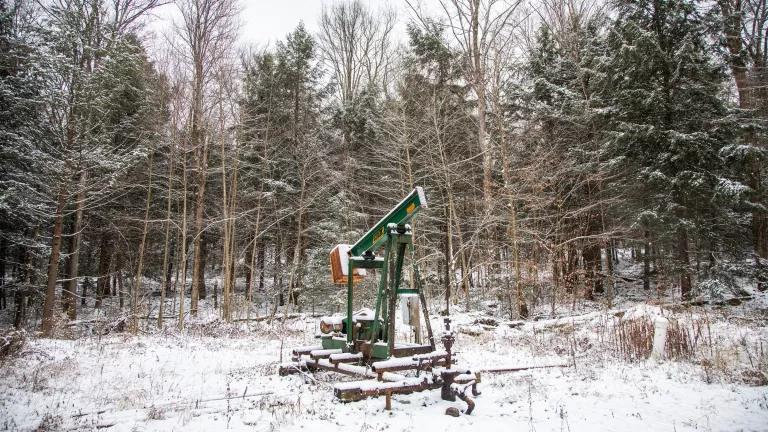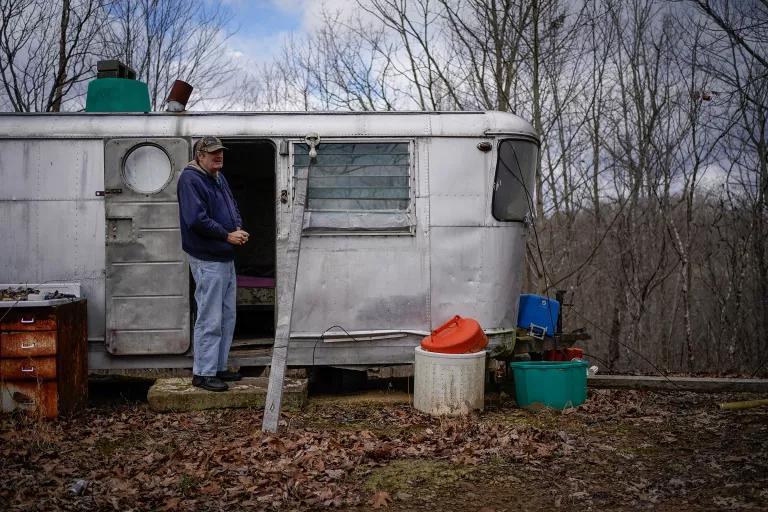Millions of Leaky and Abandoned Oil and Gas Wells Are Threatening Lives and the Climate
Biden’s Build Back Better agenda would cap them—while putting tens of thousands of people to work.

An abandoned oil drilling project in the Allegheny National Forest in Pennsylvania, where companies have abandoned thousands of wells in and around the area, walking away from cleanup responsibilities that could cost the state tens of millions of dollars.
Andrew Rush/Pittsburgh Post-Gazette via AP
When a bipartisan group of senators was hammering out the details of a proposed national infrastructure package earlier this summer, compromise was inevitable.
But one aspect of the package required little to no compromise: the call to cap the millions of orphaned and abandoned oil and gas wells that currently pockmark the country, from Alaska to New York to New Mexico. Whether it’s through the bipartisan infrastructure deal that’s currently being negotiated or through additional, upcoming recovery legislation, tackling this problem is essential—not only because these wells are dangerous polluters but also because doing so would create thousands of jobs in the process.
Taken together, these wells are a major source of air and groundwater pollution, as they continue to leak toxic substances such as arsenic and methane even after they’re no longer operational. But they also represent an all-too-rare point of political consensus: Just about everyone, from the reddest of red-state Republicans to the bluest of blue-state Democrats, agrees that the wells pose a serious threat to public health, that they need to be properly sealed, and that doing so will create jobs while making us all safer, whether from pollution or climate change or both.
Here’s what you need to know about these dangerous relics of fossil fuel extraction.
What are orphaned and abandoned wells?
Over the past hundred years, fossil fuel companies and some private landowners in the United States have drilled tens of millions of holes deep into the earth to extract oil and natural gas. When a well goes dry (as, ultimately, they all do), its operator moves on. “Orphaned” wells are those for which no former owner or operator can be located, while the term “abandoned well” typically refers to an unproductive well with a known owner/operator. In either case, the wells remain uncapped. They are essentially open holes in the ground that need to be cleaned and plugged with cement to stop their pollutants from escaping into the environment.
How many of them are there, and where are they located?
A recent investigation by Reuters estimates that the United States could have more than 3.2 million orphaned and abandoned wells. Some states have a few hundred; others have a few thousand. And some have a staggering number of them: Pennsylvania reportedly has more than 330,000 of these wells within its borders.
“Orphaned and abandoned oil and gas wells are located everywhere,” says NRDC senior advocate Joshua Axelrod. “They can be in the middle of a forest, in backyards, in farm fields, even under sidewalks and houses.” Basically, they are anywhere that oil and gas development has taken place—at sites of large-scale operation spread out over many acres as well as single-well outfits on tiny parcels of land.
Why are they so dangerous?
Simple: Because they leak. Among the chemicals that can seep out and contaminate air, soil, or groundwater are hydrogen sulfide, benzene, and arsenic. Even the smallest leaks can adversely affect the local environment if they go unaddressed or undetected for many years.
Most alarmingly, though, these wells emit a lot of methane, an odorless gas that can seep into nearby buildings (a home, school, or office, for example) and pose major health hazards. When concentrated in enclosed spaces—such as a basement or a bedroom, for instance—methane will take the place of oxygen in the lungs and can cause weakness, nausea, vomiting, and convulsions. Long-term methane poisoning can even be fatal. And methane, of course, doesn’t just make people sick: It’s also highly explosive. In 2017, two men were killed while installing a hot water heater in the basement of a home in Firestone, Colorado, that had been built adjacent to an oil and gas field. When the neighboring petroleum corporation restarted a well that had been dormant for a year, a damaged flowline filled the basement with gas, which ignited into a fireball that destroyed the house in an instant.

Hanson Rowe, a landowner who blames a leaky gas well on his Salyersville, Kentucky, property for health problems
Bryan Woolston/Reuters
What’s the connection to climate change?
Though carbon dioxide emissions are easily the largest contributor to climate change in terms of volume, methane—the second-largest contributor—is actually 86 times more potent at trapping greenhouse gases over the first 20 years of its release into the atmosphere. In other words, small amounts of atmospheric methane can have the same heat-trapping power as much, much larger amounts of CO2.
According to the Reuters investigation, which conducted a comprehensive review of the available data in 2020, orphaned and abandoned wells in the United States were collectively responsible for emitting 281,000 tons of methane into the atmosphere in 2018. The report states that the collective methane release is “the climate-damage equivalent of consuming about 16 million barrels of crude oil,” which is nearly as much oil as the United States uses in a typical day. “Plugging orphaned and abandoned wells,” says Axelrod, “would lead to a measurable decrease in methane emissions and help us meet our climate goals.”
Why haven’t the fossil fuel companies that are responsible addressed this problem on their own?
It can cost anywhere between $10,000 and $50,000 to effectively seal off an older well, and as much as $300,000 to seal off a newer, deeper one. And while oil and gas companies are legally obligated to plug their wells, the economics of the industry—combined with lax regulation by states—means that few of these operators have the cash on hand or the incentive to adequately do their duty. It’s also not uncommon for oil companies to go bankrupt, leaving them with no means of cleaning up the physical ruin that they’ve created along the way to their own financial ruin.
In either case, the responsibility of remediation almost always ends up falling to the states, many of which are cash-strapped themselves. In May, the House Natural Resources Committee introduced a bill that would incentivize states to strengthen their own regulations by tying funding to these efforts. Still, at best, this would only solve the problem going forward, not address the cleanup of the backlog of three million wells.

Nathan Graber of the New York State Department of Environmental Conservation hiking through the fog to find abandoned oil wells in Olean, New York
Lindsay DeDario/Reuters
How many U.S. jobs could a nationwide well remediation plan create?
“A lot,” says Axelrod. “The number depends on the size of the plan and the investment made. But a fairly middle-of-the-road estimate for the number of jobs that could be created if all orphaned and abandoned wells were to be located and plugged is on the order of 100,000 jobs per year for the next seven years.”
The infrastructure package proposed as part of President Biden’s Build Back Better agenda calls for $16 billion in funding to securely cap these wells (and also to close up abandoned mines, the coal industry’s version of this problem). Biden has made a point to stress that this nationwide program would create more union jobs with good wages. Many of the jobs would go to former oil and gas industry employees who have been laid off as a result of the pandemic and who would be arriving at their new work effectively pre-trained, with a basic understanding of the mechanics and technologies involved in the capping process. The president has also said that these workers would get paid “the same price that they would charge to dig those wells.”
Now that’s progress.
This NRDC.org story is available for online republication by news media outlets or nonprofits under these conditions: The writer(s) must be credited with a byline; you must note prominently that the story was originally published by NRDC.org and link to the original; the story cannot be edited (beyond simple things such as grammar); you can’t resell the story in any form or grant republishing rights to other outlets; you can’t republish our material wholesale or automatically—you need to select stories individually; you can’t republish the photos or graphics on our site without specific permission; you should drop us a note to let us know when you’ve used one of our stories.

The Uinta Basin Railway Would Be a Bigger Carbon Bomb Than Willow
A Consumer Guide to the Inflation Reduction Act
Liquefied Natural Gas 101
The Uinta Basin Railway Would Be a Bigger Carbon Bomb Than Willow
A Consumer Guide to the Inflation Reduction Act
Liquefied Natural Gas 101
The Uinta Basin Railway Would Be a Bigger Carbon Bomb Than Willow
A Consumer Guide to the Inflation Reduction Act
Liquefied Natural Gas 101
The Uinta Basin Railway Would Be a Bigger Carbon Bomb Than Willow
A Consumer Guide to the Inflation Reduction Act